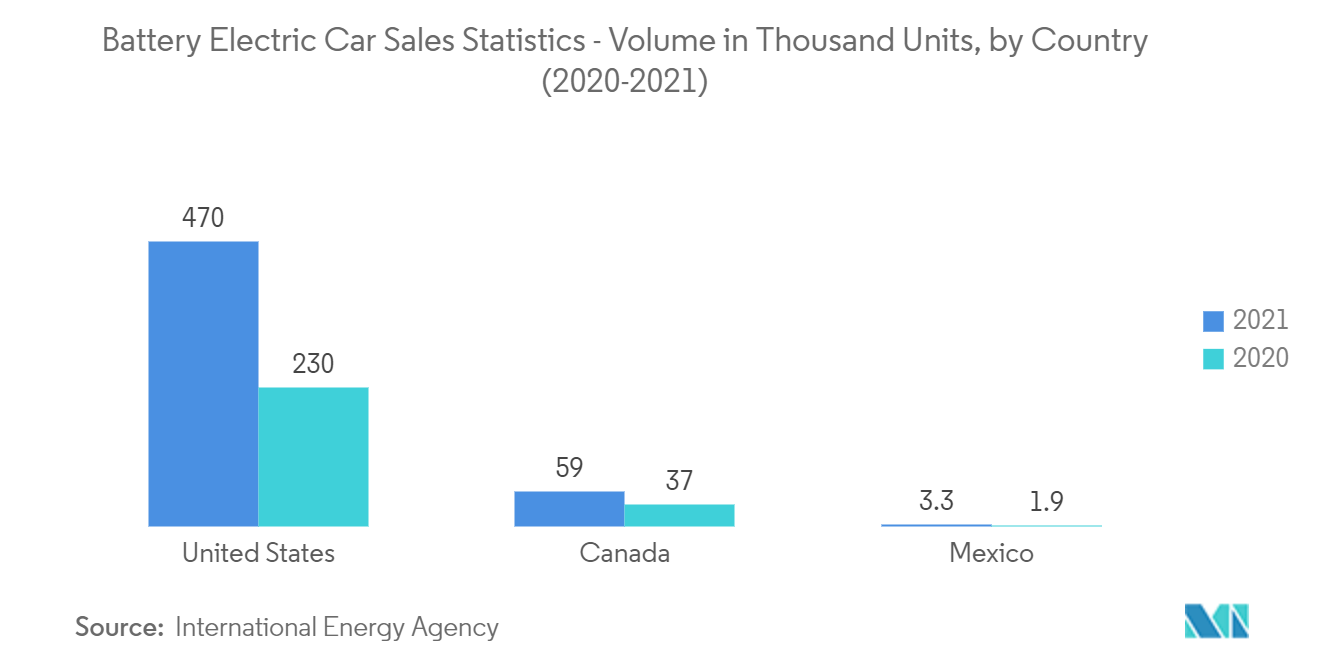Market Trends of North America Automotive Industry
This section covers the major market trends shaping the North America Automotive Market according to our research experts:
Rising Electric Mobility to Drive Demand in the Market
The increasing focus on reducing vehicular emissions has shifted the attention of the automotive industry toward electric vehicles, which are driving the market. With the growing environmental concerns, governments and environmental agencies are enacting stringent emission norms and laws that may increase the manufacturing cost of electric drive trains and fuel-efficient diesel engines in the coming years. North America has witnessed an unprecedented demand for battery-electric vehicles over the last five years. For instance,
- In the United States, sales of new light-duty chargeable electric vehicles increased to 608,000 in 2021 as compared to 308,000 in 2020. Battery electric vehicles accounted for more than 73% of the total chargeable electric vehicles sold in the country.
- Though the 2021 sales were flat compared to 2020, the growth rate since 2013 has been impressive. Although the global market declined in 2020 due to the COVID-19 pandemic, the BEVs segment has witnessed growth, and the long-term forecast of BEVs sales is optimistic.
Incentives and mandates are also boosting the demand for electric vehicles. Several incentives are being provided by the governments to encourage the sales of electric vehicles, as countries are focusing on reducing their vehicle emissions.
- The EPA and NHTSA proposed the implementation of the Safer Affordable Fuel-Efficient (SAFE) vehicles rules (2021 - 2026). These rules may set the standards for corporate average fuel economy and greenhouse gas emissions for passenger and light commercial vehicles.The Zero Emission Vehicles (ZEV) Program requires OEMs to sell specific numbers of clean and zero-emission vehicles (electric, hybrid, and fuel cell-powered commercial and passenger vehicles). The ZEV plan aims at putting 12 million ZEVs on the road by 2030.
Such developments are expected to boost the automotive market in North America over the forecast period.

The United States Likely to Occupy Significant Share in the Market
The United States is one of the major automotive industries in the world, which contributes at least 3% to the overall gross domestic product (GDP) of the country. The country manufactured close to 8.82 million vehicles in 2020, which is about 19% less than the previous year, 2019. This decline in manufacturing was mainly due to the COVID-19 pandemic and changes in the supply chains of the automobile industry.
- As of June 2020, approximately 250 million cars, trucks, and buses in the United States were powered by internal combustion engines using gasoline or diesel fuel. With the emergence of electric vehicles, the US government has been providing various tax benefits to support the purchase of electric vehicles.
- The credit for plug-in electric vehicles is a federal tax incentive for electric vehicles, where the credit ranges from USD 2,500 to USD 7,500 per vehicle, depending on the vehicle's battery capacity. This type of credit is available after the sale of 200,000 qualifying vehicles in the United States.
The government is also supporting the R&D of electric vehicles in the form of annual appropriations to the Office of Energy Efficiency and Renewable Energy (EERE). The United States is witnessing enormous demand for electric vehicles, which is majorly catered to by the Tier-1 companies. For instance, Tesla accounts for a major share of the market. Tesla Model 3, Tesla Model X, and Tesla Model S accounted for 57% of the sales, and Chevy Bolt and Nissan LEAF together accounted for 9% of sales.
The government is supporting electrification through programs and incentives like the FTA's Low or No-emission Vehicle Program and the California Hybrid and Zero-Emission Truck and Bus Voucher Incentive Project that help agencies purchase advanced technology transit buses.


